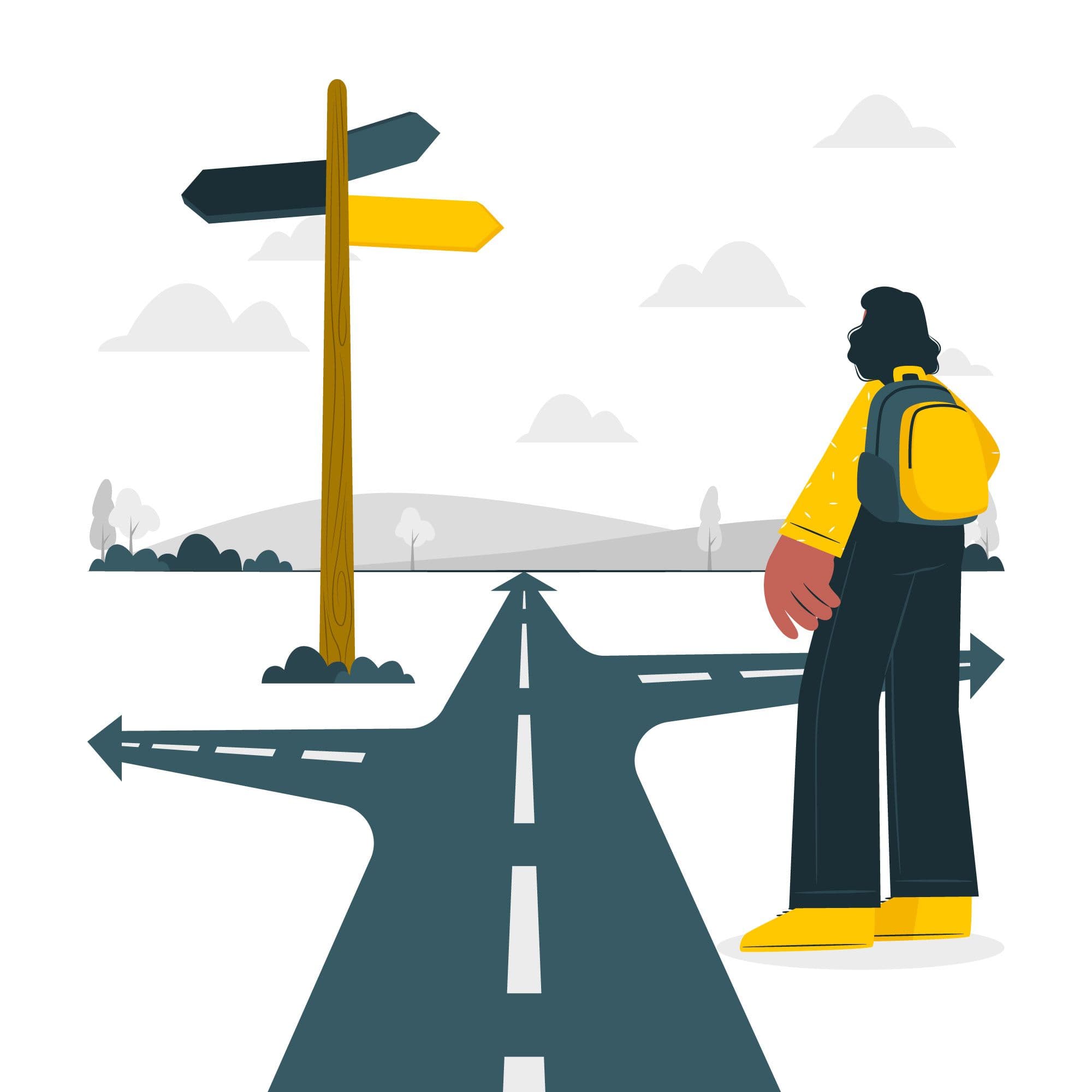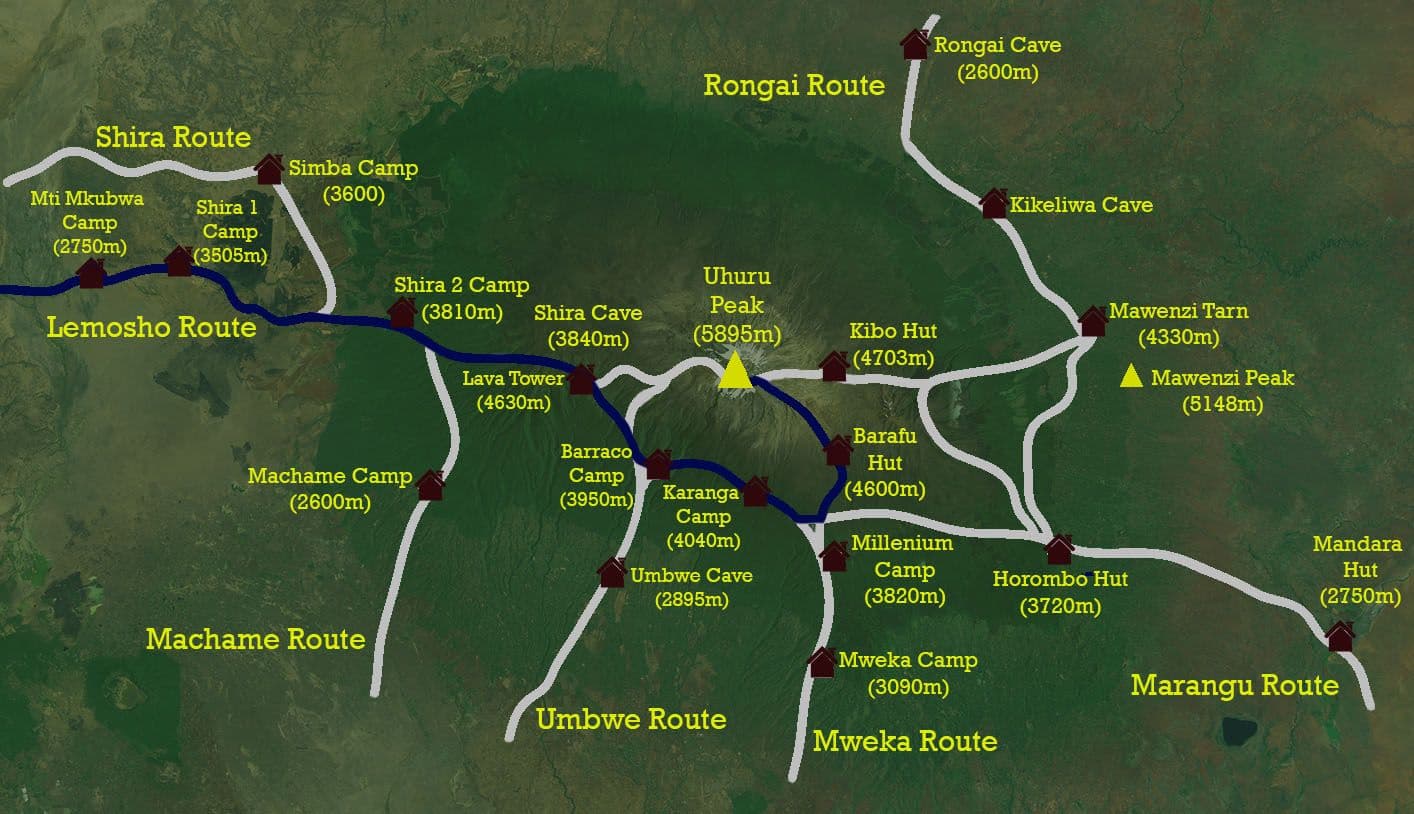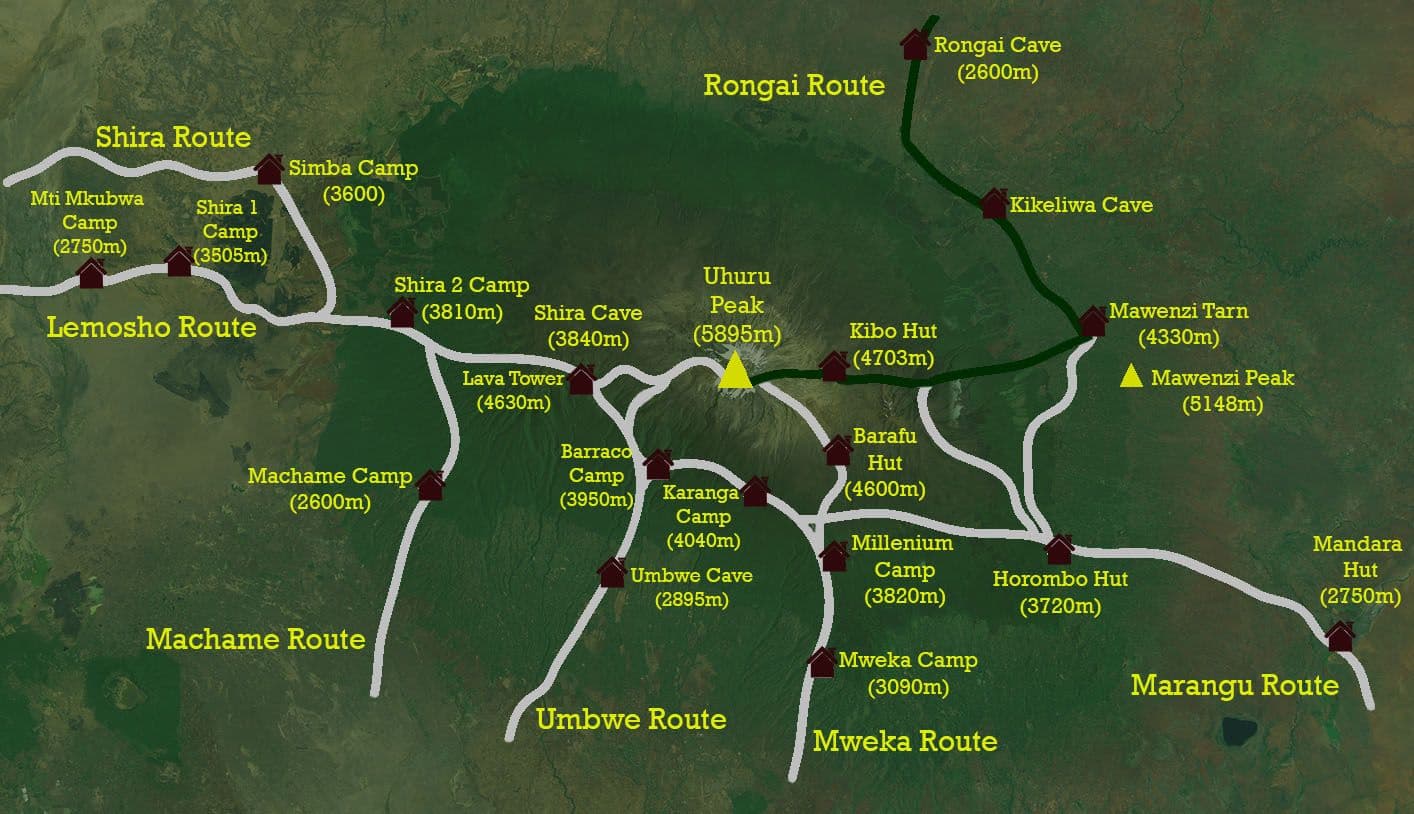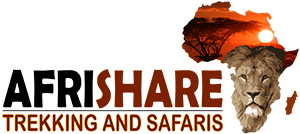
An Expert Guide to Trekking Kilimanjaro Routes | Cost | Difficulty | Distance | Training
November 1, 2023
Jamal
Explore the majestic Kilimanjaro with our expert guide. Understand the differences in routes, get insights into costs, gauge the difficulty levels, learn about the distances involved, and prepare with our recommended training tips. Your adventure starts here
Are you ready to take on the challenge of trekking Mount Kilimanjaro? This iconic mountain is one of the highest in Africa, standing at 5,895 meters above sea level. It’s no easy feat to climb it, but with the right preparation and guidance, you can experience a once-in-a-lifetime adventure that will leave you with lasting memories. This guide will help you climb Kilimanjaro. It covers everything from picking a route, getting ready for the climb, to understanding the cost and difficulty. So if you’re ready to make your way up this majestic mountain, read on for an expert guide to trekking through Kilimanjaro! Book for Mountain Climbing now or contact us for more information.
Overview of Kilimanjaro

Kilimanjaro is the highest mountain on the African continent, and an iconic symbol of adventure. Standing tall at 19,341 feet above sea level in Tanzania, it is an inactive volcano made up of three volcanic cones: Kibo, Mawenzi, and Shira. The mountain forms part of the Kilimanjaro National Park, which covers an area of 756 square miles and has been a popular tourist destination since the late 19th century.
People from all over the world are drawn to Kilimanjaro. It's known for its unique weather, which is warm and humid at the bottom but very cold near the top.. Kilimanjaro is famous for its many trekking routes. Each one offers a different experience, with varying levels of difficulty and cost.
The most popular route for trekking Mount Kilimanjaro is Machame Route, which takes around 5-7 days depending on your pace. This route passes through rainforest before ascending into alpine desert terrain with views over deep gorges and crumbling cliffs. Other paths like Lemosho or Marangu are easier to climb because they go up slowly. But you can still see beautiful glaciers and snowy peaks near the top. If you're looking for a tougher challenge, there are harder routes like Western Breach or Northern Circuit. These require advanced climbing skills and special gear like crampons and ice axes..
No matter which path you take or how you get ready, climbing Mount Kilimanjaro is an amazing adventure. It will make you feel excited and also show you how beautiful nature is.. This guide will help you climb Kilimanjaro. It covers everything from picking a route, getting ready for the climb, to understanding the cost and difficulty. So if you're excited to explore this amazing mountain, keep reading! Book for Mountain Climbing now or contact us for more information.
Choosing a route

Regarding trekking Mount Kilimanjaro, one of the most important decisions that climbers need to make is choosing the right route for their needs. There are seven main routes available for tackling the mountain, each with its own advantages and disadvantages.
The Machame Route is the most popular route up Kilimanjaro, and is considered moderate in terms of difficulty. It offers stunning views of Mawenzi and Kibo peaks as well as lush forests along its path. The Lemosho Route is a longer version of the Machame Route that takes climbers through dense rainforest before reaching the summit. However, it also offers climbers more time to acclimatize along the way. The Marangu Route is often seen as easier because it goes up slowly and has lodges along the way. But it doesn't have as many great views as the other paths.
For those looking for a more technical climb, there are two routes available: Western Breach and Northern Circuit. These are much more difficult than other routes due to their sheer elevation gains and technical sections that require climbing experience and special equipment such as helmets, crampons, ice axes, etc.. In addition, both these routes require an additional acclimatization day on top of what’s required on other routes due to their extreme altitudes.
When choosing a path up Kilimanjaro, climbers need to think about a few things. They should look at how well they can adjust to high altitudes, as some paths give more time for this. They also need to think about practical things like where they can get water or take breaks, as some paths have these and others don't. They should also think about how hard the climb is, as some paths are tougher than others. Lastly, they need to decide how long they want to take. Some people might want a quick climb, while others might want to take their time and enjoy the views at different heights. Ultimately, choosing which route will depend on personal preferences, but by researching each option carefully before making a decision can guarantee an unforgettable experience!
GET FREE QOUTE
Lemosho's route

The Lemosho route is the longest and most demanding of the seven routes available for trekking Kilimanjaro. Taking 8 days to complete, it traverses through lush rainforest before ascending the mountain. It's a great choice for those looking for a more leisurely climb, as the gradual ascent gives plenty of time to acclimatize.
The Lemosho route is also known for its stunning beauty and abundance of wildlife, so be sure to take your camera to capture some amazing views! Trekkers can choose between two summit options: a less strenuous path along the Barafu ridge, or a more challenging option along the Arrow Glacier. The latter requires advanced climbing knowledge and special equipment.
No matter which path you pick, there will be parts that will need special climbing skills. So, make sure you're ready before you try this route. Consider factors such as altitude acclimatization, logistical considerations like how far away services are located, and overall difficulty level when choosing your route.
Overall, the Lemosho route is a great way to experience Kilimanjaro in all its glory while taking it easy at your own pace. With panoramic views, abundant wildlife, and plenty of opportunities for rest days during your journey, it’s an unforgettable journey that few will ever forget!
Machame route

The Machame Route is one of the most popular routes to Kilimanjaro, also commonly referred to as the "Whiskey Route" due to its challenging nature. This is a week-long trek that begins in the south near a place called Machame Gate. It takes trekkers towards the west, where they can see amazing views of the Shira Plateau, Kibo, and Mawenzi. This route requires some scrambling and using an ice axe, but is well worth the effort due to its high success rate with acclimatization.
One advantage of this route is that it offers multiple summit options depending on how much time you have for your ascent. There are two main routes - the Shira Plateau option and the Western Breach option - both of which offer different levels of difficulty. The Shira Plateau option is shorter than other routes and has a higher success rate for those looking to summit quickly. The Western Breach option is longer and more difficult but rewards you with spectacular views from the top. Whichever way you choose, make sure to factor in enough acclimatization time before trying either route.
Climbers need to make sure they have the right gear. This includes things like headlamps, walking sticks; warm clothes like base layers and waterproofs, and sun protection like a hat and sunglasses. They should also bring lots of snacks for energy, a first aid kit with blister treatment, and lots of water bottles. It might also be a good idea to hire a professional guide who knows the route well. They can give helpful advice to make the climb safer.
For those looking for a challenging yet rewarding journey up Kilimanjaro, the Machame Route is a great option – just remember to train thoroughly beforehand so that you’re prepared for what lies ahead!
Marangu route

The Marangu Route is the most popular route for climbers on Kilimanjaro, and is often referred to as the “Coca-Cola” or “Tourist” route. This is the only path that has sleeping huts with beds, mattresses, blankets, and pillows. It's a good choice if you want a more comfy trek. The Marangu Route is five days of hiking up and one day of descent, but it is also considered the least scenic of all the routes. Trekkers on this route are required to use a guide and porters provided by their tour company.
This route follows a similar path to Machame Route until reaching Kibo hut, which sits at an altitude of 4700meters above sea level. From here, trekkers will summit via Gillman Point before heading down through Mweka Village where they can catch transport back to Arusha or Moshi town. This route has well-maintained trails, which makes it easier than other routes due to its gradual elevation gain.
This trail is more comfortable, so people usually go slower. This means they can usually reach the top in about 5 days. But if you need more time, you can stay longer. This can help you get used to the altitude and make it more likely that you'll succeed. There are a few water sources along this trail which usually have not been treated, so make sure you carry some water purifying tablets with you as well!
If you're looking for an easier way to climb Kilimanjaro and still want to see beautiful views, the Marangu Route could be a good choice. Just keep in mind that you'll need to hire porters from your tour company to use the sleeping huts! With its gradual elevation gain, experienced guides, and comfortable amenities available onsite – this could be just what you need while tackling Kilimanjaro!
Rongai route

The Rongai Route offers a tranquil and serene trekking experience, perfect for those looking for a peaceful journey up Kilimanjaro. Starting from the north side of the mountain, this route begins from a remote location near the Kenyan border and takes up to 8 days to complete. Along the way, climbers can expect to take in a variety of scenery, ranging from moorland to lush forest sections. This makes it an ideal option for those seeking an exciting and varied trekking experience.
With its low crowds and long duration, the Rongai Route is perfect for those looking for an unforgettable climb up Kilimanjaro. The journey begins with a relatively easy trek along gentle terrain before ascending steeply towards Kibo Hut. From here, hikers will ascend up through jagged rock fields before reaching Gilman's Point - one of two main summits on Kilimanjaro (the other being Uhuru Peak). Trekkers should be prepared with plenty of warm clothing layers as temperatures drop significantly at night - even during warmer months!
Trekkers who choose this route can expect stunning views across both sides of the mountain - east or west - depending on their chosen summit path. Climbing in either direction gives you different experiences; while going east offers spectacular sunrises; heading west provides amazing sunsets. The descent follows the same path down as you took on your ascent.
Overall, Rongai Route is an excellent option for those wanting to tackle Kilimanjaro in peace and comfort while still enjoying beautiful views along the way. As this route has lower foot traffic than other routes like Machame or Marangu, it is ideal for those seeking a more private experience while still having access to helpful porters and knowledgeable guides who can assist with navigating trails or provide cultural insight into local traditions along the way.
Shira's route
For those looking for a memorable and relatively straightforward trek up the highest mountain in Africa, the Shira Route is an excellent option. This route offers a shorter duration than most of Kilimanjaro's other trails - usually 6 days - with spectacular views and plenty of wildlife sightings along the way. On the Shira Route, trekkers can see special things like The Great Barranco Wall and Heim Glacier. They'll also go through different climates, from tropical rainforests to icy glaciers. It's important to be ready both physically and mentally for this trail. But don't worry, if you're climbing the Shira Route, you'll still have energy when it's time to reach the top at Gillman's Point or Uhuru Peak, which is the highest point in Africa.
Northern Circuit
For those who wish to take on a more secluded and remote ascent up Kilimanjaro, the Northern Circuit is an ideal choice. This route takes around 8-10 days to complete, and offers trekkers the opportunity to witness some truly awe-inspiring views of the mountain's northern glaciers and craters. The trail also passes through multiple climate zones, ranging from tropical rainforests to alpine tundra.
On clear days, climbers can enjoy panoramic sights of Shira Plateau, Kibo Crater, Mawenzi Tarn, and even Mt Meru in Tanzania. Additionally, there is plenty of wildlife waiting to be spotted along the way, such as antelopes, buffalo, and monkeys.
While this journey promises incredible vistas and thrilling encounters with nature, it also presents some tough sections that must be tackled in order to reach the summit - Dabrowskiego’s Gate and Third Cave being two particularly difficult climbs due to their steepness. It is therefore essential that climbers are physically fit as well as adequately prepared for any eventuality before setting off on this adventure.
The Northern Circuit offers a unique trekking experience that will leave adventurers with lasting memories - both challenging yet rewarding!
Umbwe route
The Umbwe route on Kilimanjaro is the most challenging of all the routes available and certainly not for the faint of heart. It requires a steep and demanding climb, with a higher chance of altitude sickness due to the rapid elevation gain. The path is narrower and less well-defined than other routes, making it ideal for those looking for a more solitary journey. It also offers stunning views from the Southern Ice Fields on the Western Breach.
Due to its difficulty level, it is essential that climbers are adequately prepared before trying this route. Experience helps, but even experienced hikers should take time to train to build strength and endurance. If you're new to climbing, think about doing a course to get used to different altitudes. This can make your climb safer and more fun. The trek on this route usually takes about 6 days. But some people stay longer to enjoy the view or do things like safaris or visit local villages. Make sure to plan well so you don't run out of supplies like food, water, clothes, and the right gear. The Umbwe route can be tough, but it's worth it. You'll see amazing views that you can only get by going off the beaten path through Kilimanjaro's forests, grasslands, deserts, and glaciers. And the feeling of reaching the top of one of Africa's highest mountains is something you'll remember for a long time. So, are you ready to go?
Preparing and training for the climb
Regarding trekking up Kilimanjaro, preparation and training are essential for success. With an elevation of 19,341 feet (5,895 meters), the mountain is no easy feat to tackle. Proper physical fitness and strength training will be needed to handle the steep climbs and long days on the trail. Additionally, trekkers should make sure they acclimatize to the change in altitude before setting off.
The right equipment is also important for a successful Kilimanjaro climb. Hikers should pack light but strong clothes, good hiking boots, and camping gear if they need it. They should also bring lots of snacks and drinks to keep their energy up during the hike. And don't forget any medicine they might need. Having the right equipment can make all the difference when it comes to comfort on the trail and safety during times of emergency.
Staying hydrated and nourished during your climb is key to success on Kilimanjaro. Water is essential for maintaining energy levels throughout the ascent while proper nutrition will provide trekkers with enough nutrients to keep going even when faced with difficult terrain or challenging weather conditions. Trekkers should plan for meals and snacks and bring along items that are high in protein such as nuts or jerky as well as carbohydrates like oatmeal or energy bars for sustenance throughout their journey.
Overall, preparing properly is crucial before attempting a climb up Kilimanjaro. Getting fit will help climbers keep going on their journey. Having the right gear means they'll have what they need for a safe climb up Africa's highest peak. It's also important to drink enough water and eat enough food. These are key steps for a successful climb that all hikers should take seriously before they start this famous mountain trail.
Cost and best time to visit
The cost and best time to visit Kilimanjaro are two important factors to consider when planning a trek. The cost of a climb varies depending on the route and number of days, with the Marangu route typically being the most affordable. The best time to visit is also dependent on individual goals, as different times may be more suitable for summiting or wildlife viewing.
The best time to reach the top is usually from November to March. This is because it's cooler and there are fewer storms. But keep in mind that this is also the busiest season. This could mean higher prices and more people at campsites on popular paths. April to June is usually a better choice for wildlife viewing, although this period can see heavy rains throughout parts of Kilimanjaro National Park. The weather is important to consider. The rainy season is usually from mid-March to mid-May, which can make some trails harder to walk. Also, some paths might be closed at certain times of the year for safety reasons or park closures. So, climbers should do their research before they book their trip.
Cost is another factor. Many tour operators have packages that include things like accommodations, meals, equipment rental, and porter fees. Prices can start at 1000 USD and go up, depending on the path and how long the climb is. So, climbers should look for a good deal from a trusted company with experienced guides. There might also be discounts if you book early or travel outside the peak season, which is usually from November to February.
By thinking about their budget, goals, and the best weather, climbers can plan a fun Kilimanjaro trek. This can help keep costs down without giving up safety or quality service.
Difficulty of trekking Kilimanjaro
Trekking up Kilimanjaro is not a task for the faint of heart. The mountain stands at 19,341 feet (5,895 meters) above sea level and is located within Tanzania’s expansive and diverse terrain. It can be a strenuous and challenging climb that requires physical fitness, strength training, and proper preparation to complete it successfully.
The weather on Kilimanjaro can range from hot during the day to freezing temperatures at night. This makes it important for trekkers to bring the right clothing and equipment for cold weather conditions, such as waterproof jackets, hats, and gloves. Additionally, trekkers should also bring enough food and water to sustain themselves for the duration of the climb.
The terrain can also be difficult to navigate due to its steep inclines and rocky surfaces. Trekkers should come prepared with proper walking boots or shoes that provide good grip on all types of surfaces, including mud, snow, rock or gravel. They should also bring along any camping gear necessary if they plan on staying overnight at one of Kilimanjaro’s base camps or mountain huts.
The duration of a climb up Kilimanjaro depends on which route you take but typically takes between 5-9 days depending on your pace and condition. It’s important to consider your own physical abilities before attempting any climb so that you don’t overexert yourself or put yourself in danger by trying to rush through it too quickly without taking regular rests along the way.
Overall, trekking through Kilimanjaro is an unforgettable experience that will challenge even experienced climbers - but with the right preparation and training it is possible for anyone with determination and courage to reach its summit!
